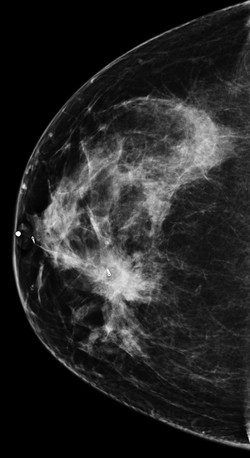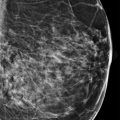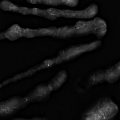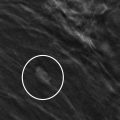Presentation and Presenting Images
( ▶ Fig. 91.1, ▶ Fig. 91.2, ▶ Fig. 91.3, ▶ Fig. 91.4)
A 46-year-old female recently diagnosed with multifocal invasive ductal carcinoma of the right breast presents for a second opinion on treatment options.
91.2 Key Images
( ▶ Fig. 91.5, ▶ Fig. 91.6, ▶ Fig. 91.7)
91.2.1 Breast Tissue Density
The breasts are heterogeneously dense, which may obscure small masses.
91.2.2 Imaging Findings
The imaging of the left breast is normal (not shown). The right breast demonstrates a 3-cm irregular mass at the 1 o’clock location, 7.5 cm from the nipple (circle in ▶ Fig. 91.5 and ▶ Fig. 91.6) with spiculated margins and an associated postbiopsy clip. In the retroareolar region there is a postbiopsy clip (arrow).
Tomosynthesis was only done in the craniocaudal (CC) projection and slices 1 to 38 of 82 suggest that the retroareolar findings extend to the base of the nipple; however, there is the suggestion of a fat plane behind the nipple on the mediolateral oblique (MLO) conventional mammogram (broken arrow in ▶ Fig. 91.6). This is difficult to assess on the digital breast tomosynthesis (DBT) imaging ( ▶ Fig. 91.7) because the nipple (marked with a BB) is not in profile.
91.3 Diagnostic Images
( ▶ Fig. 91.8, ▶ Fig. 91.9, ▶ Fig. 91.10, ▶ Fig. 91.11)
91.3.1 Imaging Findings
Both masses seen on mammography are seen on sonography. On mammography there was the suggestion that the retroareolar mass extended to the base of the nipple. Sonography confirms that the retroareolar mass (circle) extends to the base of the nipple (arrow) ( ▶ Fig. 91.8 and ▶ Fig. 91.9).
Magnetic resonance imaging (MRI) demonstrates that the retroareolar mass (circle) extends to and involves the nipple ( ▶ Fig. 91.10 and ▶ Fig. 91.11).
91.4 BI-RADS Classification and Action
Category 6: Known biopsy-proven malignancy
91.5 Differential Diagnosis
Multifocal malignancy: In this case, the diagnosis of multifocal malignancy is already known. The task for the radiologist with a known cancer diagnosis is to determine if there are additional foci of malignancy in the same or another quadrant of the breast. Determining multifocality versus multicentricity will help the patient and the surgeon decide the appropriate surgical options.
Multiple radial scars: Radial scars may present as spiculated lesions. The clinical history is not appropriate for this diagnosis.
Multiple summation shadows: The 1 o’clock mass persisted and was well seen, not compatible with a summation shadow. The retroareolar mass was better seen on the CC view suggestive of the possibility of a pseudomass; however, ultrasound and MRI confirm a true lesion.
91.6 Essential Facts
Additional imaging is necessary when DBT findings are equivocal. Spot-compression tomosynthesis imaging was not performed but may have been helpful to evaluate the retroareolar region of the right breast.
Multifocal or multicentric breast cancer is defined as the presence of two or more tumor foci within one quadrant of a breast or within different quadrants of a breast, respectively.
Breast-conserving lumpectomy may be performed in patients with multifocal and multicentric breast cancer if the disease can be completely removed with good cosmesis.
91.7 Management and Digital Breast Tomosynthesis Principles
The ability of DBT to eliminate the effects of overlapping breast tissue may result in an increase in the diagnosis of multifocal and multicentric malignancies.
Although there is an 8-hour training program for radiologists prior to interpreting DBT images, confidence with using this new modality will be gained with continued usage.
The suggestion of a fat plane on the MLO view in this case did not confer benignity.
Radiologists must be cautious and not incorrectly conclude that the presence of fat within a mass is synonymous with benignity. The presence of fat suggests benignity with encapsulated or pseudoencapsulated masses. DBT is excellent in defining capsules and pseudocapsules.
91.8 Further Reading
[1] Freer PE, Wang JL, Rafferty EA. Digital breast tomosynthesis in the analysis of fat-containing lesions. Radiographics. 2014; 34(2): 343‐358 PubMed
[2] Gentilini O, Botteri E, Rotmensz N, et al. Conservative surgery in patients with multifocal/multicentric breast cancer. Breast Cancer Res Treat. 2009; 113(3): 577‐583 PubMed

Fig. 91.1 Right craniocaudal (RCC) mammogram.
Stay updated, free articles. Join our Telegram channel

Full access? Get Clinical Tree








